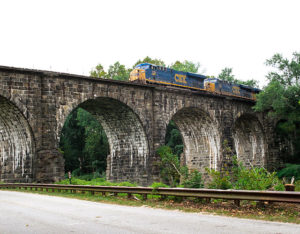Freight comes first on rail in Ohio’s passenger system
Written by jroodOhio's planned passenger rail system could be on a collision course with another one of the state's key economic priorities - expanding its powerful, growing freight and logistics industry, Business First of Columbus reports. The state's plan for a passenger line calls for running passenger trains on heavily traveled freight tracks that crisscross the state instead of putting them on dedicated lines, as may be done in other states such as California.
The plan raises questions
over how to manage a reliable passenger rail system on a highly complex freight
network whose owners are likely to place a priority on their cargo deliveries
ahead of passenger cars, especially if Ohio succeeds in expanding its role as a
logistics and shipping hub for the Midwest.
"We’re a freight
railroad, and serving our customers is paramount to us," said Rudy Husband, a
spokesman for Norfolk Southern. "We certainly need to preserve our ability to
serve our present and future freight customers on schedules that those
customers require."
Norfolk Southern, CSX Transportation
and the Indiana and Ohio Railway own the tracks on which the proposed passenger
trains would run from Cleveland though Columbus and Dayton and on to
Cincinnati. But the companies have yet to agree to the state’s plan for using
their lines.
With $400 million from
the federal stimulus program appropriated to get passenger rail rolling in
Ohio, state officials now must turn from studies and advocacy to the task of
designing and implementing a system that can operate on time to keep passengers
interested and under budget to keep taxpayers from revolting. Coming up with
such a system will be a challenge, cautioned Art Van Bodegraven, a logistics
industry veteran and consultant.
"The reality is that if
there is a high-priority freight shipment, CSXT or NS are not going to park
that freight somewhere while a passenger train with three people on it comes
through," he said.
While Ohio officials are
touting passenger rail as an economic driver, they have for years promoted
freight rail as an economic engine that will grow as gasoline prices increase,
the economy improves and the state continues to attract freight transfer yards
and other shipping projects.
The potential for
conflict has not gone unnoticed. Before it threw its support behind passenger
rail, the Columbus Chamber sought assurances from the Ohio Department of
Transportation that passenger train plans would not get in the way of freight
priorities, said Dan Ricciardi, executive director of the Columbus Region
Logistics Council, an affiliate that promotes logistics industry development.
State officials said they
are confident passenger and freight interests can operate in harmony.
"I think you’re seeing a
much greater acceptance of passenger rail on freight rail corridors because
freight rail companies are getting it that if these improvements are made to
enable the running of passenger trains, then there is a benefit in it for them,"
said Stu Nicholson, a spokesman for the Ohio Rail Development Commission, the
state group leading the passenger rail push.
The state planned to use
$273 million of the stimulus outlay for capacity-boosting track improvements
that, in addition to accommodating passenger trains, would reduce track
congestion and improve the flow of freight traffic.
Husband of NS welcomes
such upgrades, but said the company still has a set of demands it wants
satisfied before it allows passenger trains on its tracks. The demands include
staying out of the way of freight shipments, addressing questions about
liability and paying for passenger trains’ use of the tracks.
"It can be done," he
said. "But again, it’s a very complicated issue and a very expensive
proposition."
The state plans to begin
working to finalize agreements with the railroads, Nicholson said, but he didn’t
have a schedule for when the accords would be signed.
A glimpse of what the
state is facing in a passenger railroad can be found in a study completed late
last year by Amtrak. The study painted a picture of a dynamic rail system in
the state with many points of congestion and high-volume traffic.
For instance, in one area
near Cleveland where passenger rail trains would transfer from Norfolk Southern
to CSXT tracks, between 120 and 160 trains run a day. In Columbus, a planned
passenger station beneath the Greater Columbus Convention Center is near a
point where five tracks converge to two.
It said it will be up to
the state and freight railroads to work out a system that allows passenger trains
to navigate those systems so they can show up on time at the stations.
Freight rail companies
have the technology to add passenger trains to their lines, said logistics
consultant Dan Bolger, principal of Millersport-based Bolger Group. But
alleviating congestion and other issues associated with sharing tracks could be
costly, he said.
But money is on some
lawmakers’ minds. State Sen. John Husted, R-Kettering, said a passenger rail
system could become "one of the biggest money pits in Ohio history," claiming
that costs have been underestimated, particularly the public subsidy to help
run it.
The state commissioned a
preliminary study that yielded a list of track improvement projects that would
need to be performed to mitigate congestion and make room for the passenger
rail system, but those plans have yet to be finalized, Nicholson said.
But the capacity study
only took into account freight levels at the time of the study, Nicholson said.
How a system would handle increased freight traffic will have to be looked at
later, he said. Passenger schedule changes may be required as freight volume
increases amid a pickup in the economy, the Amtrak study said. A 2008 report
from the Association of American Railroads said freight railroad demand could
increase by 88 percent from 2002 to 2035.
Norfolk Southern’s goal is
to move freight using time frames provided by customers, Husband said. It would
be premature, he said, to discuss whether the railroad would be willing to
close off some of those periods to make room on its lines for passenger rail.





